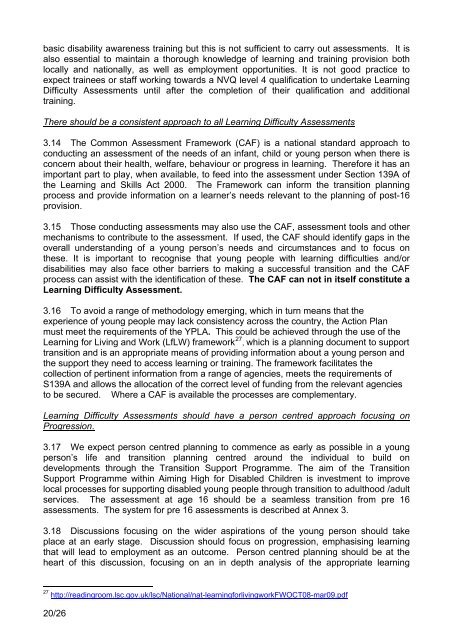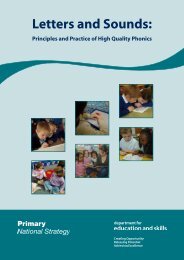Supporting young people with learning difficulties to participate and ...
Supporting young people with learning difficulties to participate and ...
Supporting young people with learning difficulties to participate and ...
Create successful ePaper yourself
Turn your PDF publications into a flip-book with our unique Google optimized e-Paper software.
asic disability awareness training but this is not sufficient <strong>to</strong> carry out assessments. It is<br />
also essential <strong>to</strong> maintain a thorough knowledge of <strong>learning</strong> <strong>and</strong> training provision both<br />
locally <strong>and</strong> nationally, as well as employment opportunities. It is not good practice <strong>to</strong><br />
expect trainees or staff working <strong>to</strong>wards a NVQ level 4 qualification <strong>to</strong> undertake Learning<br />
Difficulty Assessments until after the completion of their qualification <strong>and</strong> additional<br />
training.<br />
There should be a consistent approach <strong>to</strong> all Learning Difficulty Assessments<br />
3.14 The Common Assessment Framework (CAF) is a national st<strong>and</strong>ard approach <strong>to</strong><br />
conducting an assessment of the needs of an infant, child or <strong>young</strong> person when there is<br />
concern about their health, welfare, behaviour or progress in <strong>learning</strong>. Therefore it has an<br />
important part <strong>to</strong> play, when available, <strong>to</strong> feed in<strong>to</strong> the assessment under Section 139A of<br />
the Learning <strong>and</strong> Skills Act 2000. The Framework can inform the transition planning<br />
process <strong>and</strong> provide information on a learner’s needs relevant <strong>to</strong> the planning of post-16<br />
provision.<br />
3.15 Those conducting assessments may also use the CAF, assessment <strong>to</strong>ols <strong>and</strong> other<br />
mechanisms <strong>to</strong> contribute <strong>to</strong> the assessment. If used, the CAF should identify gaps in the<br />
overall underst<strong>and</strong>ing of a <strong>young</strong> person’s needs <strong>and</strong> circumstances <strong>and</strong> <strong>to</strong> focus on<br />
these. It is important <strong>to</strong> recognise that <strong>young</strong> <strong>people</strong> <strong>with</strong> <strong>learning</strong> <strong>difficulties</strong> <strong>and</strong>/or<br />
disabilities may also face other barriers <strong>to</strong> making a successful transition <strong>and</strong> the CAF<br />
process can assist <strong>with</strong> the identification of these. The CAF can not in itself constitute a<br />
Learning Difficulty Assessment.<br />
3.16 To avoid a range of methodology emerging, which in turn means that the<br />
experience of <strong>young</strong> <strong>people</strong> may lack consistency across the country, the Action Plan<br />
must meet the requirements of the YPLA. This could be achieved through the use of the<br />
27<br />
Learning for Living <strong>and</strong> Work (LfLW) framework , which is a planning document <strong>to</strong> support<br />
transition <strong>and</strong> is an appropriate means of providing information about a <strong>young</strong> person <strong>and</strong><br />
the support they need <strong>to</strong> access <strong>learning</strong> or training. The framework facilitates the<br />
collection of pertinent information from a range of agencies, meets the requirements of<br />
S139A <strong>and</strong> allows the allocation of the correct level of funding from the relevant agencies<br />
<strong>to</strong> be secured. Where a CAF is available the processes are complementary.<br />
Learning Difficulty Assessments should have a person centred approach focusing on<br />
Progression.<br />
3.17 We expect person centred planning <strong>to</strong> commence as early as possible in a <strong>young</strong><br />
person’s life <strong>and</strong> transition planning centred around the individual <strong>to</strong> build on<br />
developments through the Transition Support Programme. The aim of the Transition<br />
Support Programme <strong>with</strong>in Aiming High for Disabled Children is investment <strong>to</strong> improve<br />
local processes for supporting disabled <strong>young</strong> <strong>people</strong> through transition <strong>to</strong> adulthood /adult<br />
services. The assessment at age 16 should be a seamless transition from pre 16<br />
assessments. The system for pre 16 assessments is described at Annex 3.<br />
3.18 Discussions focusing on the wider aspirations of the <strong>young</strong> person should take<br />
place at an early stage. Discussion should focus on progression, emphasising <strong>learning</strong><br />
that will lead <strong>to</strong> employment as an outcome. Person centred planning should be at the<br />
heart of this discussion, focusing on an in depth analysis of the appropriate <strong>learning</strong><br />
27 http://readingroom.lsc.gov.uk/lsc/National/nat-<strong>learning</strong>forlivingworkFWOCT08-mar09.pdf<br />
20/26
















